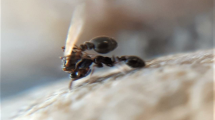Summary
Various termite researchers have noted the presence of wing pad damage apparently due to bites inflicted by other colony members. Some have reported regression of nymphal development in response to the damage. I show that the kalotermitid species Pterotermes occidentis displays significant frequencies of damaged termites in mature (alate producing) colonies, but no damage in immature colonies. Damaged termites typically develop toward the worker form (Table 1). I hypothesize that workers are biting siblings to recruit more workers and thereby improve their indirect fitness.
Similar content being viewed by others
References
Alexander RD (1974) The evolution of social behavior. Annu Rev Ecol Syst 4: 325–383
Hamilton WD (1964) The genetical evolution of social behavior I. and II. J Theor Biol 7:1–52
Hamilton WD (1972) Altruism and related phenomena, mainly in the social insects. Annu Rev Ecol Syst 3:193–232
Heath H (1927) Caste formation in the genus Termopsis. J Morphol Physiol 43:387–425
Hewitt PH, Watson JAL, Nel JJC, Schoeman I (1972) Control of the change from group to pair behavior by Hodotermes mossambicus reproductives. J Insect Physiol 18:143–150
Imms AD (1919) On the structure and biology of Archoptermopsis. Philos Trans R Soc Lond [Biol] 209:75–180
Michener CD, Brothers DJ (1974) Were workers of eusocial Hymenoptera initially altruistic or oppressed? Proc Natl Acad Sci USA 71:671–674
Miller ME (1969) Caste differentiation in lower termites. In: Krishna K, Weesner FM (eds) Biology of termites. Academic Press, New York, pp 283–310
Nutting WL (1966) The distribution and biology of the primitive dry wood termite Pterotermes occidentis (Walker) (Kalotermitidae). Psyche 73:165–179
Springhetti A (1969) Il controllo sociale della differenziazione degli alati in Kalotermes flavicollis Fabr. (Isoptera). Ann Univ Ferrara [Sez 3] 3:73–94
Watson JAL, Sewell J (1981) The origin and evolution of caste systems in termites. Sociobiology 6:101–118
West MJ (1967) Foundress associations in polistine wasps: Dominance hierarchies and the evolution of social behavior. Science 157:1584–1585
West-Eberhard MJ (1975) The evolution of social behavior by kin selection. Q Rev Biol 50:1–33
West-Eberhard MJ (1981) Intragroup selection and the evolution of insect societies. In: Alexander RD, Tinkle DW (eds) Natural selection and social behavior. Chiron Press, New York, pp 3–17
Author information
Authors and Affiliations
Rights and permissions
About this article
Cite this article
Zimmerman, R.B. Sibling manipulation and indirect fitness in termites. Behav Ecol Sociobiol 12, 143–145 (1983). https://doi.org/10.1007/BF00343205
Received:
Accepted:
Issue Date:
DOI: https://doi.org/10.1007/BF00343205




